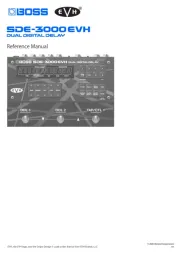Boss TU-3S Handleiding
Boss
Niet gecategoriseerd
TU-3S
Bekijk gratis de handleiding van Boss TU-3S (2 pagina’s), behorend tot de categorie Niet gecategoriseerd. Deze gids werd als nuttig beoordeeld door 51 mensen en kreeg gemiddeld 4.4 sterren uit 26 reviews. Heb je een vraag over Boss TU-3S of wil je andere gebruikers van dit product iets vragen? Stel een vraag
Pagina 1/2

Before using this unit, carefully read the sections entitled: “USING THE
UNIT SAFELY” and “IMPORTANT NOTES” (supplied on a separate sheet).
These sections provide important information concerning the proper
operation of the unit.
Additionally, in order to feel assured that you have gained a good
grasp of every feature provided by your new unit, this manual should
be read in its entirety. The manual should be saved and kept on hand
as a convenient reference.
Main Features
High Brightness mode enhances meter visibility outdoors.
Accu-Pitch Sign function uses the motion of the meter’s lights
to show when tuning is completed.
Guitar/Bass mode lets you tune by string number, with support
for 7-string guitars and 6-string basses.
Flat tuning is supported with Guitar Flat mode, which allows for
“down” tunings up to six semitones below standard pitch.
How to Use the Tuner
1. Connect the AC adaptor (sold separately).
This switches on the power and the CHECK indicator lights.
2. Connect the guitar or bass you want to tune to the
INPUT jack.
3. Play a single note on your guitar or bass, and tune it.
The note name or string number closest to the tone being played
appears in the display. Tune the instrument so that both Tuning
Guide indicators are lit and the center of the meter is lit green.
(Cent display)
The meter will light farther toward the left as the pitch gets flatter,
or farther toward the right as the pitch gets sharper.
* When the Accu-Pitch Sign function is on, the meter lights stream
toward the center of the display when stable tuning at the correct pitch
is reached.
* The meter behavior described here is when the CENT display is selected
(the factory setting). The behavior is different when you've selected the
STREAM display.
Convenient Functions
Having the Meter Indicate Completion of
Tuning (Accu-Pitch Sign function)
When the Accu-Pitch Sign function is on, the meter lights stream
toward the center of the display when stable tuning at the correct
pitch is reached.
1. While holding down the STREAM/CENT button, turn on
the power (connect the AC adaptor).
2. Press the STREAM/CENT button again to toggle the
Accu-Pitch Sign function on/off.
On: The meter lights stream to the center from the left and right.
Off: The meter lights up at the left and right.
* After making the setting, you will need to turn on the power again.
* This setting remains stored even after the power is turned off.
Changing the Reference Pitch
You can adjust the reference pitch over a range of 436-445 Hz.
(440 Hz is the factory default.)
1. Press the MODE button and STREAM/CENT button
simultaneously.
The lowest digit of the current reference pitch (e.g., “0” when set to
440 Hz) blinks in the Note Name/String indicator.
2. Press the MODE button or STREAM/CENT button to
change the reference pitch.
MODE button: Raises the reference pitch by 1 Hz.
STREAM/CENT button: Lowers the reference pitch by 1 Hz.
* If you allow several seconds to elapse without pressing the MODE
button or STREAM/CENT button, the TU-3S will return to normal
operation.
* When you turn on the power, the current reference pitch will be
displayed for several seconds.
* This setting remains stored even after the power is turned off.
Changing the Meter’s Brightness
(High Brightness mode)
By switching the meter to High Brightness mode, you can increase its
visibility when performing outdoors.
To switch to High Brightness mode, hold down the STREAM/CENT
button for two seconds or longer. To return to normal brightness, hold
down the STREAM/CENT for two seconds or longer once again.
* Normal brightness is automatically selected when you turn on the
power.
Panel Descriptions
* If you connect other effect units, you must connect them after the TU-
3S. If the TU-3S is connected after other effect units, you won't be able
to tune correctly.
1. CHECK Indicator
This indicator lights when the TU-3S is active.
2. Tuning Guide Indicator
Indicates when the proper tuning is reached.
3. Meter
Indicates the tuning of the input sound’s pitch.
4. STREAM/CENT button
Switches the meter’s display pattern.
* This setting remains stored even after the power is turned off.
CENT display
The meter lights farther toward the left as the pitch gets flatter, or
farther toward the right as the pitch gets sharper.
When the pitch is correct, the center of the meter lights green.
* The center of the meter and the tuning guide indicator remain lit for
several seconds after you’ve selected this setting.
STREAM display
The meter lights stream toward the left if the input pitch is flat, or
toward the right if the input pitch is sharp.
The lights flow more slowly as the pitch discrepancy decreases,
and stop flowing when the pitch is exact.
* The meter lights stream toward the left for several seconds after you've
selected this setting.
5. Note Name/String Number Indicator
Indicates the note name, string number, or reference pitch.
Note indicator
6. MODE Button
The tuning mode changes each time you press the MODE button.
The meter lights at the position of the currently selected mode.
* When you turn on the power, the current tuning mode will be displayed
for several seconds.
* This setting remains stored even after the power is turned off.
In this example, the Tuning mode is set to GUITAR.
7. INPUT Jack
Connect the guitar or bass guitar to be tuned here.
8. OUTPUT Jack
Connect an effects processor, guitar amp, or other such device
here.
* The tuner is always on while the AC adaptor is connected. The sound
from the OUTPUT jack will not be muted.
9. DC OUT Jack
When an AC adapter is used, you can connect a PCS-20A parallel
DC cord (optional) to supply power to effects processors and other
PSA adaptor-compatible gear.
10.DC IN Jack
Accepts connection of an AC Adaptor (PSA series: optional).
* Use only the specified AC adaptor (PSA series), and connect it to an AC
outlet of the correct voltage. Do not use any other AC adaptor, since
this may cause malfunction.
Precautions When Connecting
* To prevent malfunction and/or damage to speakers or other devices,
always turn down the volume, and turn off the power on all devices
before making any connections.
* Some connection cables contain resistors. When connection cables
with resistors are used, the sound level may be extremely low, or
impossible to hear. For information on cable specifications, contact the
manufacturer of the cable.
* Once the connections have been completed, turn on power to your
various devices in the order specified. By turning on devices in the
wrong order, you risk causing malfunction and/or damage to speakers
and other devices.
When powering up: Turn on the power to your guitar amp last.
When powering down: Turn off the power to your guitar amp first.
* This unit is equipped with a protection circuit. A brief interval (a few
seconds) after power up is required before the unit will operate
normally.
Attaching the Rubber Foot
You can attach the rubber foot (included) if necessary.
* When turning the unit over, be careful so as to protect the buttons and
switches from damage.
Specifications
TU-3S: Chromatic Tuner
English
Owner’s Manual
* 5 1 0 0 0 5 0 1 9 8 - 0 2 *
Pitch is flat Pitch is in tune Pitch is sharp
Mode Explanation Indicator Status
Chromatic Lets you tune all twelve chromatic
steps of the octave. The note name is
displayed.
Chromatic
flat
Lets you tune one semitone lower
(b) or two semitones lower (2).
Guitar Lets you tune by guitar string
numbers. The guitar string
number is displayed.
(7th string is displayed
as “7.”)
Guitar flat
Lets you tune one semitone lower
(b) or anywhere from two to six
semitones lower (2-6).
Bass Lets you tune by bass string
numbers. The bass string number
is displayed. (Hi-C string
is displayed as “C,” Lo-B
string is displayed as
“b.”)
Bass flat
Lets you tune one semitone lower
(b) two semitones lower (2), or
three semitones lower (3).
Guitar Amplifier
Electric Guitar
(Electric Bass)
AC Adaptor
(PSA series: optional)
Parallel DC Cord (accessory)
To PSA adaptor
compatible devices
such as compact
effect units
Parallel DC Cord (PCS-20A: optional)
1
2
3
8
45
6
7
9 10
C D BAGE F C
#
(Dot LED lit)
Guitar
Chromatic at
( , 2)
Chromatic
Bass at
( –3) Bass
Guitar at
( –6)
Tuning Range C0 (16.35 Hz)–C8 (4,186 Hz)
Reference Pitch A4 = 436-445 Hz (1 Hz step)
Tuning Accuracy ±1 cent
Nominal Input Level -20 dBu
Input Impedance 1 MΩ
Nominal Output Level -20 dBu
Output Impedance 1 kΩ
Recommended Load
Impedance 10 kΩ or greater
Power Supply AC Adaptor (sold separately)
Current Draw 35 mA (DC 9 V)
95 mA (DC 9 V,
when High Brightness mode is on
)
Dimensions 73 (W) x 84 (D) x 56 (H) mm
2-7/8 (W) x 3-5/16 (D) x 2-1/4 (H) inches
Weight 220 g
8 oz
Accessories
Owner’s Manual, Leaflet (“USING THE UNIT SAFELY,”
“IMPORTANT NOTE,” and “Information”), Parallel DC
cord, Rubber foot
Options AC adaptor: PSA series
Parallel DC cord: PCS-20A
DC IN
Copyright © 2016 ROLAND CORPORATION
Product specificaties
| Merk: | Boss |
| Categorie: | Niet gecategoriseerd |
| Model: | TU-3S |
Heb je hulp nodig?
Als je hulp nodig hebt met Boss TU-3S stel dan hieronder een vraag en andere gebruikers zullen je antwoorden
Handleiding Niet gecategoriseerd Boss

2 April 2025

25 Februari 2025

27 Januari 2025

30 November 2024

30 November 2024

30 November 2024

30 November 2024

30 November 2024

30 November 2024

30 November 2024
Handleiding Niet gecategoriseerd
- Avenview
- Collective Minds
- Nodor
- Gravity
- Hartke
- Ferroli
- ToughTested
- Venus
- Twisted Electrons
- Itho-Daalderop
- Esoteric
- Y-brush
- JSP
- Deltex
- Shure
Nieuwste handleidingen voor Niet gecategoriseerd

14 September 2025

14 September 2025

13 September 2025

13 September 2025

13 September 2025

13 September 2025

13 September 2025

13 September 2025

13 September 2025

13 September 2025